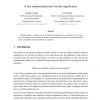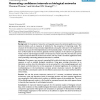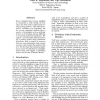RSCTC
2010
Springer
14 years 10 months ago
2010
Springer
Randomisation is a method to test the statistical significance of a symbolic rule; it is, however, very expensive. In this paper we present a sequential randomisation test which d...
138
Voted
SYNTHESE
2008
2008
How experimental algorithmics can benefit from Mayo's extensions to Neyman-Pearson theory of testing
15 years 17 days ago
Although theoretical results for several algorithms in many application domains were presented during the last decades, not all algorithms can be analyzed fully theoretically. Exp...
107
Voted
BMCBI
2006
15 years 21 days ago
2006
Background: In studies that use DNA arrays to assess changes in gene expression, our goal is to evaluate the statistical significance of treatments on sets of genes. Genes can be ...
113
Voted
BMCBI
2008
15 years 23 days ago
2008
Background: The unsupervised discovery of structures (i.e. clusterings) underlying data is a central issue in several branches of bioinformatics. Methods based on the concept of s...
106
Voted
BMCBI
2007
15 years 23 days ago
2007
Background: It is becoming increasingly important for researchers to be able to scan through large genomic regions for transcription factor binding sites or clusters of binding si...
130
click to vote
BMCBI
2007
15 years 23 days ago
2007
Background: In the analysis of networks we frequently require the statistical significance of some network statistic, such as measures of similarity for the properties of interact...
107
click to vote
BMCBI
2010
2010
On the use of resampling tests for evaluating statistical significance of binding-site co-occurrence
15 years 23 days ago
Background: In eukaryotes, most DNA-binding proteins exert their action as members of large effector complexes. The presence of these complexes are revealed in high-throughput gen...
116
Voted
HPDC
2010
IEEE
15 years 1 months ago
2010
IEEE
Sequence comparison is considered as a cornerstone application in bioinformatics, which forms the basis of many other applications. In particular, pairwise sequence alignment is a...
131
click to vote
COLING
1996
15 years 2 months ago
1996
Since treebanks have become available to researchers a wide variety of techniques has been used to make broad coverage parsing systems. This makes quantitative evaluation very imp...
113
click to vote
CIKM
2008
Springer
15 years 2 months ago
2008
Springer
Background: Accurate estimation of statistical significance of a pairwise alignment is an important problem in sequence comparison. Recently, a comparative study of pairwise stati...





